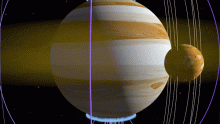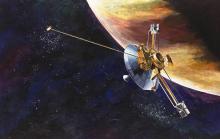Listen to today's episode of StarDate on the web the same day it airs in high-quality streaming audio without any extra ads or announcements. Choose a $8 one-month pass, or listen every day for a year for just $30.
You are here
Morning Lights
The solar system gets the new year off to a beautiful start tomorrow. The three brightest objects in the night sky will team up before and during dawn: the Moon and the planets Venus and Jupiter.
Venus is the brilliant “morning star,” and it stands close to the lower left of the Moon. Jupiter stands well to the lower left of Venus, not far above the horizon at first light.
Other than the fact that both of them are planets, Venus and Jupiter don’t have very much in common. Venus is a ball of rock a little smaller than Earth, while Jupiter is a ball of gas that’s about 11 times wider than Earth.
One thing they have in common is that both are topped by layers of bright clouds — one reason that both planets look bright. And the clouds on both of them produce lightning.
Spacecraft have heard the “crackle” of lightning in radio waves from both planets. And on Jupiter, craft have actually seen the lightning.
Jupiter’s lightning is produced in the same way as on Earth — in giant thunderstorms. Plumes of water vapor rise high into the atmosphere, where they condense to form heavy clouds.
On Venus, the clouds are made of sulfuric acid. The droplets of acid can generate an electric charge, producing lightning. The bolts probably travel between clouds, not down to the ground. But there could be lightning at the ground, too, around active volcanoes — lighting up the surface of our closest planetary neighbor.
Script by Damond Benningfield





